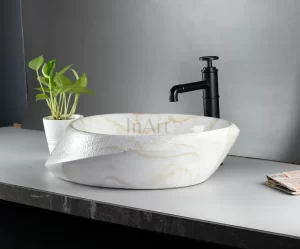
How to Elevate Your Bathroom Ceiling
The bathroom ceiling may seem like an insignificant detail, but it can have a major effect on its surroundings. By choosing an eye-catching style or adding texture, this surface can add character and elevate your overall design scheme.
Beadboard is an timeless classic that adds visual texture and warmth, while humidity-resistant gypsum boards offer smooth surfaces that can be painted any color or style imaginable.
Hexagon Tile Ceiling
Hexagon tiles add an eye-catching feature to your ceiling, and are an excellent way to bring interest to a neutral bathroom without overwhelming it with too many colors or patterns.
A hexagon tile bathroom provides the ideal backdrop for a variety of decor styles. Even in its plain medium-size configuration, hex tiles lend themselves well to pairing with wood (wood-effect porcelain floor tiles or real wooden furniture) in steampunk environments that bring together timber’s organic lines with geometric hexagon shapes.
For an expressive design, decorative hexagon tile bathrooms can create an eye-catching mural effect using a combination of hexagon and rectilinear tiles. Or use hexagon tiles to frame a shower enclosure or WHB with their geometric character highlighted. Nowadays, there are an assortment of shapes, sizes, materials and acoustic versions with sound absorbing qualities available that you can choose from for this task.
Recessed Coves
Lighting can often be underestimated as an integral element of bathroom design, yet it can make a major impactful statement about both its form and function. Recessed lights, commonly referred to as can lights or downlights, are popular choices because they offer both task lighting as well as ambient illumination without taking up too much floor or wall space. Take advantage of recessed bathroom lighting by highlighting design features while eliminating shadowy corners in nooks and corners.
Select recessed light trim that matches your bathroom hardware to create a cohesive style, or go bolder by opting for chrome or brass trim for an updated aesthetic. As safety measures, always opt for “wet location” (shower-location rated fixtures) fixtures in the tub/shower area to ensure waterproof housings.
Use recessed lighting to set a relaxing atmosphere in your bath by lighting drapes or features such as stairs. Choose warm or cool bulbs depending on what best complements your color scheme and set the atmosphere for ultimate relaxation.
Natural Wood Ceiling
Wood ceilings create a striking focal point that adds dimension and sophistication to a bathroom, be it Bohemian-inspired or feminine in design – natural wood can enhance any design scheme!
Wood is an ideal material for bathroom walls and floors due to its ability to withstand moisture and humidity levels. However, in order to protect its durability against water damage such as mold or mildew growth, the wood must be treated and sealed correctly to extend its longevity and maintain its lifespan.
Certain wood species make an ideal addition to a bathroom, such as hickory and cherry. Both of these can be sanded to achieve a sleek, modern or traditional finish and pair nicely with any decor style. Carbonized bamboo offers another great choice because of its strength, light weight and unique Asian aesthetic; however it must be protected with either boiled linseed oil or urethane to prevent warping or warping caused by high moisture environments.
Concrete Ceiling
Concrete ceilings are increasingly popular choices in modern construction projects due to their low maintenance needs and durable nature, though the finished product can look rough or ugly at first. A skim coat of plaster or drywall compound may be required in order to give an acceptable appearance for interior rooms.
Schulberg Demkiw Architecture Studio of Elwood, Australia designed and installed a stunning concrete bathroom as part of their renovation, featuring a stunning bathtub made out of concrete and beautiful mood lighting to complete its look.
Don’t just try to hide concrete finishes – instead transform it with a fresh coat of paint! Before beginning painting, sand the surface with 150-grit sandpaper to roughen and porify the surface so the paint adheres better; wipe down to remove dust or dirt; use waterproofing primer if possible for long-term results.



Average Rating